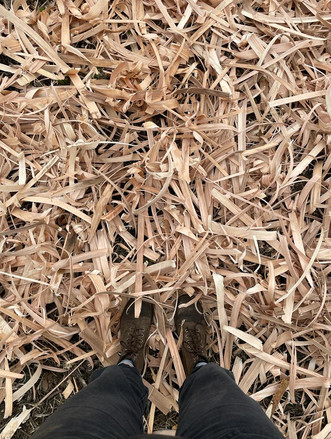As Autumn draws in, leaves fall and we start to put our fields to bed, we think about the myriad of organic mulches and bagged composts available to us. Which to choose? Is it actually necessary to buy any at all? What we do know is that buying peat based horticultural products is damaging to our environment. Added to practically all commercial composts for years, due to its spongy texture and seemingly natural abundance, we have over time learned that it is in fact not an ecologically conscious choice. There have been efforts to slow down and end commercial consumption of it for some time now.

We’ve wanted to write about peat for a while and with the latest news revealing many UK bodies are still making little effort to avoid peat - see Donald Campbell's recent Guardian piece on this - it felt like the right time to say a few words. There’s a lot of information out there and the length of this post is testament to the complexity of the matter. We know we are by no means covering every angle here so we’ve pulled together some resources that might be of interest for further reading below.
As well as acting as a crucial habitat for wildlife and insects, peat bogs absorb and store carbon. This is because peat is produced by the decomposition of bog plants: It is formed in the watery environment of an oxygen-free bog, which means it decomposes into carbon. This carbon is then stored in the bog, locked away from the atmosphere for ever (as long as they are not extracted). In the UK bogs store more carbon than all Europe's forests. However when peat is extracted, this natural carbon absorption is reversed. Once a peat bog is drained, it begins to dry out and will eventually die. A dead peat bog will then begin to release its stored carbon into the atmosphere, which contributes to global warming.
Peat is said to be a ‘renewable’ resource. However peat formation happens very, very slowly - it takes 1000 years for 1 metre of peat to form. So while it is technically renewable it is by no means renewable in a way that can keep up with us using it in the quantities we currently consume. It is much harder to restore a peat bog than to replant a forest.
There are already some positive moves in the protection of the UK’s peat bogs and the government has pledged to have all gardening products containing peat banned by 2024 (although; this has been pushed back from the original target of 2020). Primarily because it’s cheap and still very easily accessible; with the vast majority of peat for horticulture being imported from Ireland - it’s still being sold widely at garden centres and accounts for 35% of all UK compost sales. There’s plenty of peat-free alternatives for gardeners; B&Q even have a peat-free range. We are curious to understand better the transparency of supply chains for alternative ingredients (eg. coconut coir), which although in plentiful supply are imported from much farther afield and more costly; does this actually make for a better buying decision environmentally?

Raising awareness is key to slowing down consumer consumption of the still very readily available products containing peat before it is banned for sale to all horticulturists in the UK. We are doing our best this autumn to prioritise making use of the abundant and accessible materials such as leaf-mulch, grass cuttings, plain recycled cardboard and straw to care for our plants both inside and out.
JESSICA BLUME
Discover More






Comments